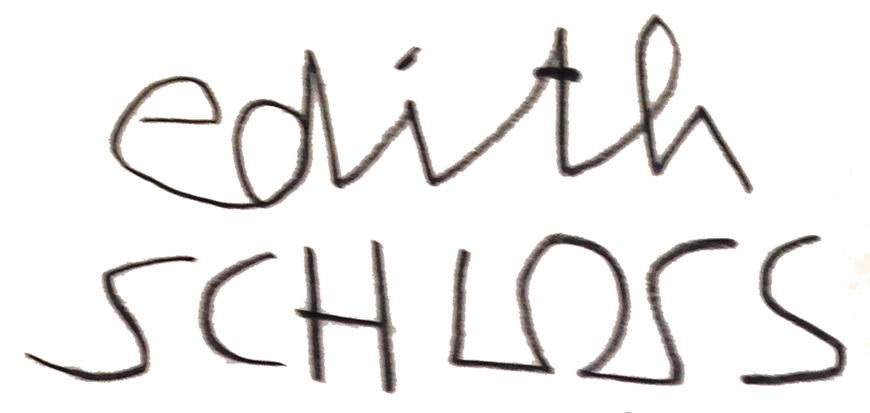Biography
Edith Schloss is best known for knowing "everyone who counted in Manhattan's legendary postwar art scene." From the moment she was first introduced to Willem de Kooning by her friend Fairfield Porter, she became an integral member of the Chelsea-New York art scene, which flourished around the New York School and included photographer, painter, and filmmaker Rudy Burckhardt (whom she married in 1946) and the Jane Street Group around the artist Nell Blaine. It was an era closely charted in her 2021 posthumous memoir, The Loft Generation: From the de Koonings to Twombly; Portraits and Sketches, 1942–2011.
Born in Offenbach, Germany, Schloss studied languages and art as a young student. In Florence she learned about the Renaissance and in Frankfurt she saw her first Van Gogh. In London, while working as an au pair, she learned English and was inspired by the great Greek sculptures at the British Museum, which led her to dream of becoming an archeologist.
During the London Blitz, Schloss sailed to America in a convoy. Arriving in New York she met the political refugee Heinz Langerhans, who introduced her to Bertolt Brecht, prominent Communist Ruth Fischer and others. She studied at the Art Students League of New York with Will Barnet, Harry Sternberg and Morris Kantor (1942-1946). She listened to lectures by American pragmatists such as John Dewey at The Cooper Union and other great thinkers at The New School for Social Research. There never seemed to be a moment when she didn’t consider herself an artist. "Somehow I always drew, made pictures," she wrote.
She exhibited in numerous galleries in New York beginning in the mid-1940s and had her first solo exhibition in the Ashby Gallery in 1947. As Abstract Expressionism took hold in New York and action painting grew more dogmatic, Schloss set aside her figurative intentions and turned to collage and assemblage "because it was in an avant-garde technique it was considered alright by the abstractionists." Assemblage bridged her interest in writing and art and for a time, she become better known for her boxes than for her paintings. In 1961, she was included in the landmark exhibition The Art of Assemblage at The Museum of Modern Art.
She would continue to exhibit in group and solo shows throughout the city during the 1950s, including in the legendary cooperatives Tanager Gallery, Workshop Gallery, and Jane Street Group.
In 1962, with her marriage to Rudy growing strained, she left for Italy with the intent of staying three months—she stayed for a lifetime. There she met Giorgio Morandi in his summer home in the mountains above Bologna. Cy Twombly became a neighbor and close friend, and the American experimental composer Alvin Curran became her lover. She drew inspiration from Etruria and Magna Graecia and later the caves at the Sahara. In 1964, she opened her first exhibition at the Galleria Aleph in Rome, followed by countless others throughout Italy over the years.
Schloss's passion for the paintbrush was only matched by her passion for the pen. As she settled into her new life in Rome, she returned to writing art criticism (during the 1950s she was an Editorial Assistant at Art News). She became the leading cultural voice in Italy as Art Editor for the International Herald Tribune from 1968 to 1986. Later she wrote regularly for Wanted in Rome. Her keen eye, not only for the historic but also the contemporary, led her to be one of the first to write about Jean-Michel Basquiat and Francesca Woodman, among others. In addition to her critical writings, she published books of her poetry, authored and illustrated children's books, and created set designs and record covers for Alvin Curran.
The experience of New York, Rome and the Mediterranean offered Schloss a wide range of stimuli and inspiration. Yet over time her work grew more and more focused on the intimate and the sublime. She sought the “quiet and balance in still lifes of homespun objects lined up against the pageant of the sea." She continued to exhibit regularly both in Europe and New York at the Green Mountain Gallery and Ingber Gallery.
In the late 1970s, Schloss introduced a figure, a single diver based on one in a tomb in Paestum. “I added swimmers, falling or striving bodies, somehow playing the myths of pursuits and surrender." These figures gave Schloss an enhanced narrative and she painted them as lovers, warriors, heroes and gods. They became the trademark of her late work celebrated for their myth, their vitality and their spontaneity. “They tell of giving death and making life."
Reviews and articles on her work have appeared in The New York Times, Art in America, Art News, Arts Magazine, Flash Art, Hyperallergic, among others.
Monographic presentations have included Klingspor-Museum, Offenbach, Germany (1990); Il Museo del Louvre, Rome (1997); The Keats-Shelley House, Rome (2006); St. Stephen’s School, Rome (2000); Galleria Giulia Arte Contemporanea, Rome (2009); Centro Arte Moderna e Contemporanea della Spezia (CAMeC) (2013), and Sundaram Tagore Gallery, New York (2015).
Schloss's work can be found in prominent private collections in New York, London, Paris, Berlin, Frankfurt, Tokyo, Sydney, Rome, Milan, Ferrara and La Spezia. Her work is represented in the public collections of The Metropolitan Museum of Art, New York; the Keats-Shelley House, Rome; the Hessisches Landesmuseum, Wiesbaden and the Offenbacher Stadtmuseum, Offenbach, Germany, to name a few.

